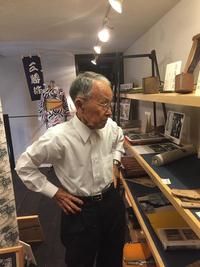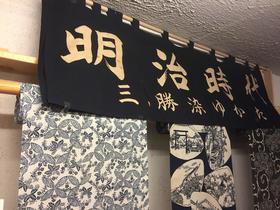A number of “Machikado Exhibition Halls” have been established in Chuo-ku, one of which, “Yukata Museum,” is located in an alley close to Ningyocho Station. One day, I made a reservation in advance by telephone before visiting.
This facility has a part of the building of Sankatsu Co., Ltd. as an exhibition hall. The director, Keisaburo Shimizu, was a very calm narrative and carefully talked about the history and traditional techniques of dyeing in Edo. I was allowed to shoot specially.
 Some of the yukata fabrics that are decorated are wonderful items that make use of the old techniques of the Meiji era. It was Kotaro Shimizu, an exclusive craftsman of Sankatsu, who left the very time-consuming technique of "medium-type dyeing" with certain skills. He later became a living national treasure, but he is the father of the current director.
Some of the yukata fabrics that are decorated are wonderful items that make use of the old techniques of the Meiji era. It was Kotaro Shimizu, an exclusive craftsman of Sankatsu, who left the very time-consuming technique of "medium-type dyeing" with certain skills. He later became a living national treasure, but he is the father of the current director.
When I asked the director about the origin of the name "Sankatsu", it was said that the founder's name was Hanichi Amano, so he named it "Sankatsu Hanichichi" in Joruri. This work was tailored to Joruri's work based on a suicide incident in Osaka during the Edo period, and until Meiji period it was a popular kyogen that everyone knew.
"Glossy women's clothing" is sometimes performed in Bunraku even today. There is a famous line that appears in the stage of a liquor store. "Where are you going to do this now?"
In the neighborhood of Ningyocho, which has long prospered as a city of puppet ballad drama and Kabuki, it was also a day to feel the taste of such a name.


